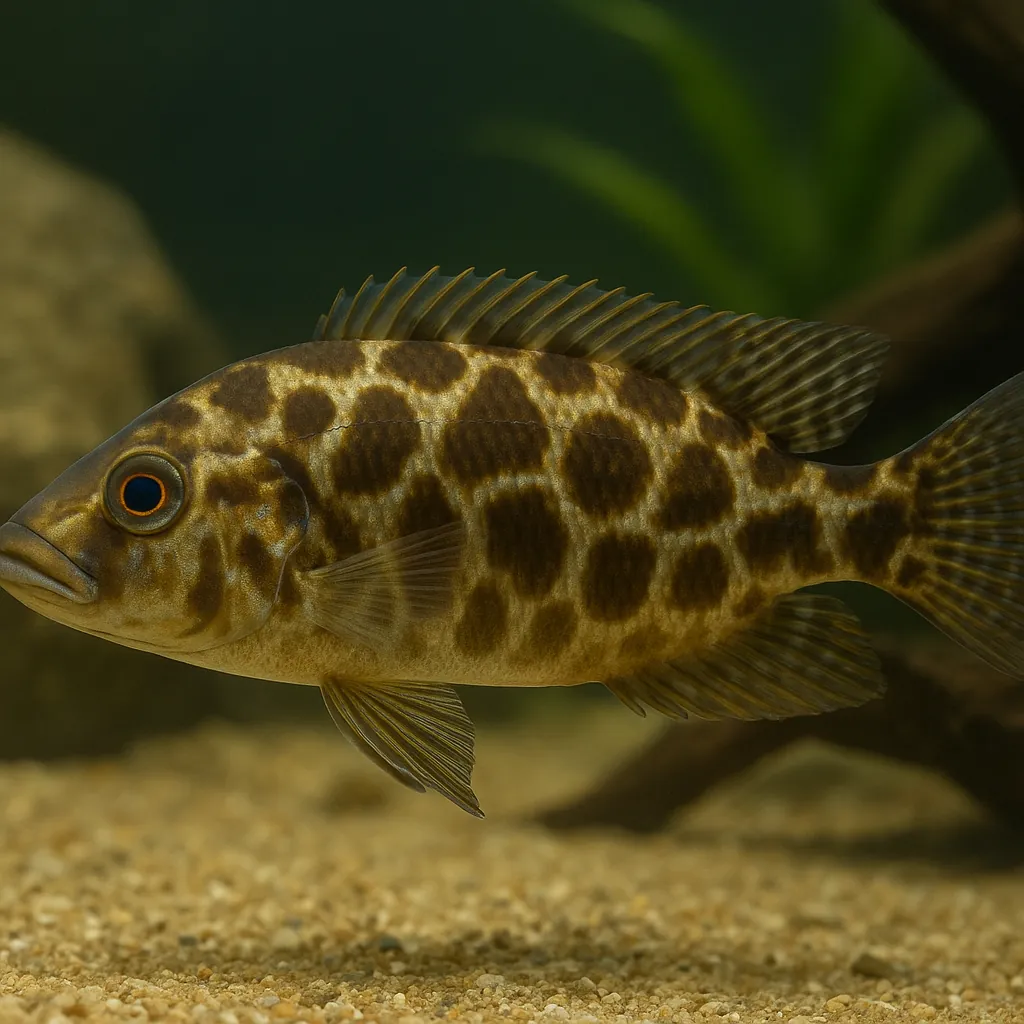
Giraffe cichlid
Introduction
The Giraffe Cichlid, scientifically known as Nimbochromis venustus, is a captivating freshwater fish native to Lake Malawi in Africa. Its distinctive giraffe-like pattern and vibrant coloration make it a popular choice among aquarists. While their striking appearance is appealing, Giraffe Cichlids require specific care and a well-maintained environment, making them more suitable for hobbyists with some experience in fishkeeping.
Care and Environment
Providing optimal care for Giraffe Cichlids involves attention to tank size, water parameters, diet, and tank setup.
What is the minimum tank size for a Giraffe Cichlid?
A single adult Giraffe Cichlid requires a minimum tank size of 208 liters (55 gallons). However, for a group or to accommodate their active nature, a larger tank of at least 450 liters (120 gallons) is recommended.
What are the ideal water parameters for Giraffe Cichlids?
Maintain water temperatures between 22-27°C (71.6-80.6°F), with a pH range of 7.5 to 8.5, and water hardness between 10-15 dGH.
How should the tank be set up for Giraffe Cichlids?
Use a sandy substrate to mimic their natural habitat. Incorporate rocks and caves to provide hiding spots and establish territories, which can help reduce aggression. Ensure decorations are securely placed to prevent toppling, as these fish are known to rearrange their environment.
Giraffe Cichlids are carnivorous and thrive on a high-protein diet. Offer a variety of live or frozen foods such as brine shrimp, bloodworms, and small fish. They can also be conditioned to accept high-quality cichlid pellets. Feed them in moderation to prevent overfeeding and maintain water quality.
Due to their size and feeding habits, Giraffe Cichlids produce a significant amount of waste. A robust filtration system is essential to maintain water quality. Regular water changes of 20-30% weekly are recommended to keep nitrate levels low and ensure a healthy environment.
Origin and Habitat
Giraffe Cichlids are endemic to Lake Malawi in East Africa. They inhabit both rocky and sandy areas of the lake, often found in regions with open swimming spaces interspersed with rocks and caves. The lake's environment is characterized by stable temperatures and alkaline water conditions, which should be replicated in the aquarium to ensure their well-being.
Temperament and Compatibility
Giraffe Cichlids exhibit semi-aggressive behavior, especially during breeding periods. They are territorial and may display aggression towards conspecifics and other tank mates.
Can Giraffe Cichlids be kept with other fish?
Yes, they can coexist with other African cichlids of similar size and temperament. Suitable tank mates include Malawi Peacocks, Synodontis catfish, and other Haplochromis species. Avoid housing them with smaller or more passive fish, as they may be perceived as prey.
How can aggression be minimized in the tank?
Providing ample space and creating distinct territories with rocks and caves can help reduce aggression. Maintaining a proper male-to-female ratio, such as one male to two or more females, can also prevent excessive competition and stress.
Interesting Facts
Giraffe Cichlids are known for their unique hunting strategy in the wild. They exhibit a behavior called "playing dead," where they lie motionless on the substrate, luring unsuspecting smaller fish close before swiftly capturing them.
During breeding, males undergo a striking color transformation, developing a bright yellow body with a blue face, which contrasts sharply with their usual giraffe-like pattern.
These cichlids are mouthbrooders; after spawning, the female carries the fertilized eggs in her mouth for about three weeks until the fry are ready to be released.
Sources
All information in this article has been gathered from the following reputable sources:
Overview
Recommended Tank Size 118.9 Gallons (for groups of 6 or more) |
Minimum Group Size 1 |
Minimum Tank Volume 54.9 Gallons |
Maximum Adult Length 9.8 inches |
Average Adult Length 7.9 inches |
Shoaling (6+ required) No |
Preferred Water Type Freshwater, alkaline |
Temperature Range (°C) 22-27 |
pH Range 7.5-8.5 |
Water Hardness (dGH) 10-15 |
Typical Lifespan (years) 8 years |